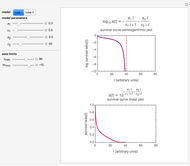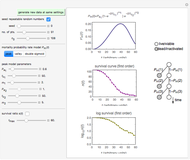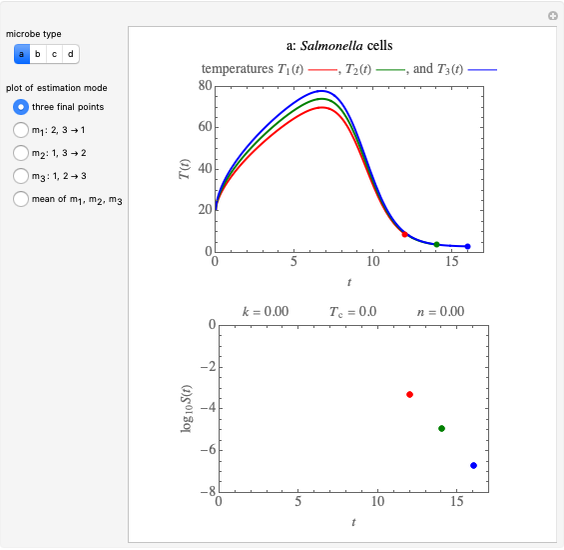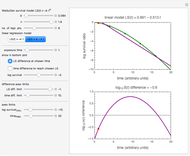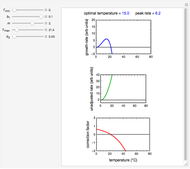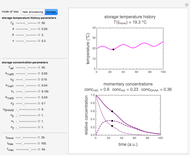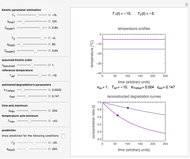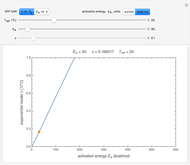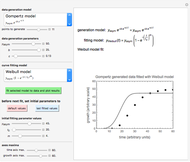Extracting Microbial Inactivation Parameters from Final Isothermal Survival Ratios

Requires a Wolfram Notebook System
Interact on desktop, mobile and cloud with the free Wolfram Player or other Wolfram Language products.
Theoretically, at least, when a microbe’s thermal inactivation kinetics follows a three-parameter model, the three parameters can be estimated directly from the final survival ratio after three heat treatments, avoiding the need to record the entire survival curve. This Demonstration shows the method with simulated isothermal survival data of two bacterial cells and two bacterial endospores using the Weibull Log-Logistic (WeLL) model with a constant shape factor. The WeLL model’s three parameters are the temperature,  , marking the inactivation onset;
, marking the inactivation onset;  , the slope of the rate parameter rise at temperatures well above
, the slope of the rate parameter rise at temperatures well above  ; and
; and  , the shape factor of the isothermal inactivation times’ distribution, assumed to be practically temperature independent in the pertinent range. The three parameters are determined by numerically solving the three simultaneous survival equations of which they are the three unknowns.
, the shape factor of the isothermal inactivation times’ distribution, assumed to be practically temperature independent in the pertinent range. The three parameters are determined by numerically solving the three simultaneous survival equations of which they are the three unknowns.
Contributed by: Mark D. Normand and Micha Peleg (April 2013)
Open content licensed under CC BY-NC-SA
Snapshots
Details
Snapshot 1: the three-point method applied to Salmonella-like cells
Snapshot 2: the three-point method applied to E. coli-like cells (mean values)
Snapshot 3: the three-point method applied to Bacillus-like endospores
Snapshot 4: the three-point method applied to Clostridium-like endospores (mean values)
Traditionally, microbial thermal inactivation parameters are determined by fitting several isothermal survival curves with what is known as the primary model, followed by describing the temperature dependence of these parameters by what is known as the secondary model. It has been demonstrated [1, 2, 3] that if the inactivation kinetics is known to follow a particular three-parameter model, this model’s parameters can be determined directly from the final survival ratios after isothermal (and non-isothermal) heat treatments without recording the entire survival curves.
This Demonstration illustrates the principle with simulated isothermal inactivation data of two bacterial cells, Salmonella and E. coli type, and two endospores, heat-resistant Bacillus and Clostridium, that you choose by clicking "a," "b," "c," and "d," respectively, in the setter bar. Their isothermal heat inactivation is described by the Weibull Log-Logistic (WeLL) model [4]:  , where
, where  is the momentary survival ratio at time
is the momentary survival ratio at time  , that is,
, that is,  where
where  and
and  are the momentary and initial numbers, respectively;
are the momentary and initial numbers, respectively;  marks the inactivation onset temperature;
marks the inactivation onset temperature;  is the slope of the rate parameter at
is the slope of the rate parameter at  ; and
; and  is the Weibullian distribution’s shape factor. Where
is the Weibullian distribution’s shape factor. Where  the isothermal survival curve has downward concavity, and where
the isothermal survival curve has downward concavity, and where  it has upward concavity ("tailing"). What is known as "first-order inactivation kinetics" is a special case of the Weibullian model where
it has upward concavity ("tailing"). What is known as "first-order inactivation kinetics" is a special case of the Weibullian model where  . After three isothermal heat treatments at temperatures
. After three isothermal heat treatments at temperatures  ,
,  , and
, and  of durations
of durations  ,
,  , and
, and  , the corresponding final survival ratios are
, the corresponding final survival ratios are  ,
,  , and
, and  , and their logarithms are
, and their logarithms are  ,
,  , and
, and  . Assuming that the come-up and cooling times are negligible, we have three equations:
. Assuming that the come-up and cooling times are negligible, we have three equations:  ,
,  , and
, and  , and three unknowns:
, and three unknowns:  ,
,  , and
, and  , which are the cells' or spores' survival parameters in the particular medium.
, which are the cells' or spores' survival parameters in the particular medium.
These three parameters are calculated in the Demonstration and displayed above the graph depicting the corresponding recreated survival curves. Because the simultaneous solution of the three nonlinear equations is sensitive to even minute experimental scatter in the final survival ratios, we have adapted a special iterative procedure where the parameter  rises incrementally from a small value (or falls decrementally from a high value). For each new value of
rises incrementally from a small value (or falls decrementally from a high value). For each new value of  , two equations (those for
, two equations (those for  and
and  , for example) are solved to extract the corresponding values of
, for example) are solved to extract the corresponding values of  and
and  . These in turn are used to calculate the final survival ratio at the third temperature (
. These in turn are used to calculate the final survival ratio at the third temperature ( in this case) and compared with the actual value. Once the difference is smaller than the chosen tolerance (0.05 in this Demonstration), the corresponding values of
in this case) and compared with the actual value. Once the difference is smaller than the chosen tolerance (0.05 in this Demonstration), the corresponding values of  ,
,  , and
, and  are considered the sought survival parameters [2]. The procedure can be repeated by solving the equations of the final survival ratios at
are considered the sought survival parameters [2]. The procedure can be repeated by solving the equations of the final survival ratios at  and
and  and testing the solutions against the final survival ratio at
and testing the solutions against the final survival ratio at  . A third alternative is to solve the equations of the final survival ratios at
. A third alternative is to solve the equations of the final survival ratios at  and
and  and test the solutions against the final survival ratio at
and test the solutions against the final survival ratio at  . Averaging the parameter values obtained in these three combinations is also an option, chosen with the last radio button. (To increase the results' reliability one can use the procedure with final survival ratios obtained at four or more temperatures, which will dramatically increase the number of combinations and allow the identification of outliers by statistical criteria [1, 3].)
. Averaging the parameter values obtained in these three combinations is also an option, chosen with the last radio button. (To increase the results' reliability one can use the procedure with final survival ratios obtained at four or more temperatures, which will dramatically increase the number of combinations and allow the identification of outliers by statistical criteria [1, 3].)
Notice that the Demonstration is only intended to illustrate the principle and method. In their actual use, the solutions need to be verified by predicting the survival curves at temperatures and time conditions, isothermal or dynamic, not used in the calculation of survival parameters, which will confirm the inactivation model.
The method described in this Demonstration can also be used for other static antimicrobial treatments such as chemical preservation [1], but the program would need substantial modification to extract the survival parameters from dynamic inactivation data, such as when the come-up and cooling times are not negligible [2, 3].
References
[1] M. G. Corradini, M. D. Normand, C. Newcomer, D. W. Schaffner, and M. Peleg, "Extracting Survival Parameters from Isothermal, Isobaric and 'Iso-concentration' Inactivation Experiments by the '3 End Points Method'," Journal of Food Science 74(3), 2009 pp. R1–R11. onlinelibrary.wiley.com/doi/10.1111/j.1750-3841.2008.00980.x/full.
[2] M. Peleg, M. D. Normand, M. G. Corradini, A. J. van Asselt, P. de Jong, and P. F. ter Steeg, "Estimating the Heat Resistance Parameters of Bacterial Spores from Their Survival Ratios at the End of UHT and Other Heat Treatments," Critical Reviews in Food Science and Nutrition, 48(7), 2008 pp. 634–648. dx.doi.org/doi:10.1080/10408390701724371.
[3] M. G. Corradini, M. D. Normand, and M. Peleg, "Prediction of an Organism's Inactivation Patterns from Three Single Survival Ratios Determined at the End of Three Non-Isothermal Heat Treatments," International Journal of Food Microbiology, 126(1–2), 2008 pp. 98–111. www.sciencedirect.com/science/article/pii/S0168160508002420.
[4] M. Peleg, Advanced Quantitative Microbiology for Food and Biosystems: Models for Predicting Growth and Inactivation, Boca Raton, FL: CRC Press, 2006.
Permanent Citation







